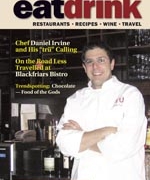At a Snail’s Pace
Escargot will never be something I willingly choose from a menu. Not that I can’t stomach a few snails if I need to when pressured into a Survivor-style challenge, I just prefer my shelled food to come from salt water rather than the garden. My wife doesn’t have such hang-ups and has been begging me to try escargot for years, insisting I will love the buttery and garlicky morsels. I often remind her that before we met I had never eaten escargot, never even considered putting those dirty little things in my pristine mouth, and I have gotten along just fine.
“I can have butter and garlic on things other than garden vermin,” I remind her. “My resistance is mainly due to texture anyway.”
“Texture?” she sneers. “What about taste? Isn’t that what food is about?”
“Only if it tastes good enough to mask an unsatisfying texture.”
As much as I will do anything for my wife, I am moving rather slowly on trying her prized escargots, just like the fabled speed of this (so-called) food item. In my travels, I have chosen or been swayed into eating all manner of odd food: chicken feet doused in fiery sauce. I willingly drink kombucha, a fermented concoction of tea and probiotics that many others label as putrid and undrinkable. Thankfully, I was not bold enough in Iceland to track down the rotten shark meat served as a delicacy, not did it inadvertently come across my path by any hospitable Icelanders, because I would have felt obligated to try it against my better judgement. I enjoy all manner of seafood, but snails fall into a different category than scallops, shrimp, and squid. Not that escargot should be categorized as seafood on restaurant menus, but it is the closest comparison in my mind since it doesn’t normally share the plate with any true brethren (slugs and larvae are absent on most menus). It is quite understandably in its own league. The escargot stands alone.
They even have specially-designed plates that have no other purpose in the kitchen. Even though this dish is not commonplace or eaten regularly even by the people who like them, it is so esoteric that it requires its own plate. And if you happen to get them served in the shells, there is another specialized set of tongs to grip them while a fork extracts the meat. These kitchen utensils are used for nothing else, so the escargot following must be very strong to garner such abstruse implements.
I have found with escargot, people either love them or hate them. I am married to one who brags about eating them since she could eat solid food. I have watched my wife eat them on numerous occasions and maybe I haven’t given them a fair trial. Once at Tru restaurant, she ordered the Escargots with Wild Mushrooms in a Pernod Cream Sauce as her appetizer. I dare say that any escargot fan will fall in love with this dish. Even though this opinion is based on hearsay, I am confident that my interpretation of the moans and groans of pleasure coming from across the table could only mean there are no better escargot in the city. To back this up, my wife vowed to return to Tru to order the escargot again as an appetizer and then a second portion for her entree. Apparently, they are that good.
After years of continuous prodding, I finally agreed to not only try them, but have her cook me an entire serving. The French are known for cooking them expertly, but my wife has a tried and true recipe that her grandfather taught her. He even gave her those special plates to make them in. As I watched my wife prepare the escargots, I dare say there isn’t much effort required. Unless you’re excavating them yourself from the backyard garden, all you need to do is pop open a can, drop them in the divots on the plate, add whatever goes on top, and stick them in the oven.
“Ready in ten minutes,” my wife says.
As she closes the oven, I open the fridge and grab an Alexander Keith’s. “No offence to your cooking, but a snail is a snail and I don’t think I can do this without the comfort of a beer by my side.”
She pulled the tray out of the oven and one of the circular divots on the plate was empty.
“One has left the pan,” I exclaimed incredulously. “Where did it go?”
“They tend to explode if they get too hot,” my wife offered.
“Explode? As in disintegrate into thin air? As in blow-up?”
“It just popped out of the dish. It’s right here on the tray,” she said, picking it up with a fork and putting it back into its cubby hole on the special plate. “That’s the fastest its moved in its whole life.”
“It was most likely trying to get away from being cooked,” I offered. “Or trying not to be eaten.”
“Well they can’t escape now,” my wife smiles, eyeing her creation. “Let’s eat.”
My plate had six divots in it and I cleared them all out to my wife’s satisfaction. And the result? I had to choke down the sixth as much as the first. The garlicky, buttery, salty, cheesy sauce they steeped in was tasty, but could not disguise the rubbery texture of what I was really eating. If it had been over anything else – a piece of garlic bread, say – it would have tasted the same minus the chewy residue of the snail. Jonathan Swift is credited for saying the bravest man who ever lived was the first one to eat a raw oyster. I wonder if this was the same guy who thought snails from a garden would be a good accompaniment to such delicious sauces. I guess we’ll never know why the French choose these gastropods from the dirt to put their wonderful sauces on, but they’re responsible for frog legs too, so who’s to say what they’re really thinking.
After a lifetime of resistance, the snail has finally and slowly made its way into my personal gastronomic spectrum and, more particularly, into my belly. But the way I see it, eating should not be about overcoming obstacles or fears. Eating is one of life’s most unadulterated pleasures. If I’ve moved slowly at trying what my wife considers an exquisite delicacy, it is only so I can cram foods that I enjoy into my mouth and not one’s that have a questionable palatability in the food chain.










